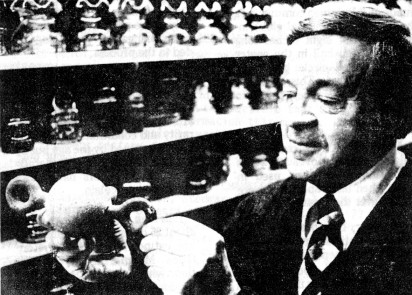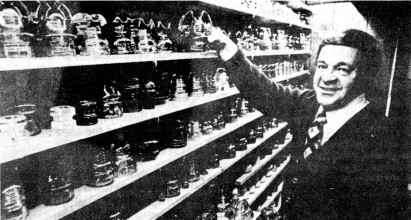Insulator Collector of the Month
Reprinted from "INSULATORS - Crown Jewels of the Wire", August 1978, page 4
INSULATOR COLLECTOR OF THE MONTH
(The following article was taken from the December 13, 1977, issue of THE
ARGUS, local newspaper of Rock Island, Illinois.)
Rock Islander has collection of 700 insulators from U.S. and seven foreign
countries
By HELEN GORDON
(Argus staff writer)
Mickey Mouse - Roman Helmet - Bat Ears - Coolie Hat - are nicknames of some
of the glass and porcelain insulators collected by Jack Bateman, 1856 43rd St.,
Rock Island.
The insulators are from power, telephone and telegraph lines where they were
installed to prevent leakage of electricity from conductors to the ground and
other conductors and also to eliminate arcing, moisture and noise, Bateman
explains.
ALMOST ALL NEW lines now are being buried or a cable is used and insulators
are not required so they are becoming more and more of a collector's Item.
Bateman, an engineering associate for Iowa-Illinois Gas & Electric Co. at
the Rock Island service building, has been finding, trading and buying the
rainbow-colored beauties of the high wire for about eight years, He has about 500
glass and 200 porcelain insulators. He also has a few made from mica and rubber.
As he walks slowly past the rows of shelves in the families' recreation room,
Bateman moves from one insulator to another, pointing out, "This one is
from Mexico and this from Spain and I have others from Canada, France, England,
Germany, Australia, Ireland and Portugal."
THERE ARE STORIES behind many of his insulators.
One is from a trolley car in Chicago and was picked up in a scrap yard in Davenport. Another is a
combination lightning rod and insulator which farmers, primarily in Ohio, had
custom made.
Friends of the Batemans from Moline, Bob and Beverly Trevor, were traveling
in Europe and carried back home on the plane a bucket full of insulators from
France for Jack.

UNUSUAL INSULATOR -- One of the most unusual insulators in Jack
Bateman's collection is this globe type which came from the Hauberg
garage in Rock Island. He also has two other different sizes of this
same style. |

INSULATOR COLLECTION - Jack Bateman of 1856 43rd St., Rock Island,
reaches for a Columbia insulator from among his large collection in the
family room of their home. He has about 500 glass insulators and 200
made out of porcelain.
(Argus Photos by Jim Collins) |
"I wish I knew what this was made of," Bateman comments as he displays
an unusual globe insulator about eight inches long with a 2-inch ball in the
center with a metal circle projecting from each end. This insulator came from
the Hauberg garage in Rock Island.
JACK HAS TWO threadless insulators that are over 100 years old. They were
often used in trees when telegraph wires were strung over the mountains.
However, the threadless type proved unsatisfactory because it often became
separated from the tree or pole peg. About the time of the Civil War, the
threaded pin was invented.
Bateman's insulators range in size from several inches to about a foot high.
Some have grooves at the top for the wire and others, at the side. Drip points,
which look like tiny glass beads, are on some of the insulators to hasten the
water off the glass before it had time to cause a short in the power.
"THE SHAPES AND colors vary according to the different size wire,
voltage and cable. However, some companies offered unique designs for the
promotion aspect," Bateman explains.
The most common color is aqua but his display also includes a variety of
shades of amber, green, blue, milk glass, purple and carnival glass.
The purple glass originally was clear and is the only glass known which, when
exposed to the ultra-violet rays of the sun, changes to an amethyst color. That
glass was manufactured only in the period of 1880 to 1914 when manganese was
being added to the process.
THE COLLECTIBLE insulators range in price from $1 to $1,500, depending on
age, color, rarity and condition. The value is not determined by the age but by
the quantity available. Generally the glass insulators have more value than
porcelain.
Bateman has insulators from about 25 different companies. All are extinct now
but one. Kerr Glass Manufacturing Corporation, which makes canning jars,
produces glass insulators only on special order for replacements.
Bateman said that any insulators being installed presently on new lines are
made of porcelain, which is more durable than glass, in a sky blue-grey color to
cooperate with the national beautification program.
JACK IS A MEMBER of the National Insulator Association. He had a display of
duplicates for sale and trade at the annual convention in Lakeland, Fla.
Other shows held throughout the country are listed in Insulator publications
along with collector's names and addresses.
Bateman also likes to haunt flea markets and antique stores to pursue his
hobby. He cautions new enthusiasts about trespassing in search of insulators or
trying to take insulators off live wires. Four people were electrocuted last
year while trying to take an insulator off a live power wire.
| 